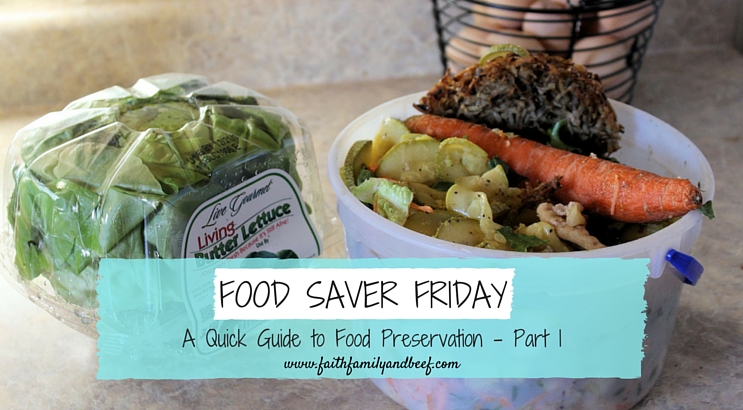This Food Saver Friday we are talking food preservation, which is like food storage but different. Preservation is food storage for the long-term, you know – canning, dehydrating, and freezing.
A Quick Guide to Food Preservation – Part 1
My mom, and my Ball Blue Book® Guide to Preserving which Mom gifted me, are my go-to resources on all things food preservation. For more than one hundred years, Ball has been celebrating the art of home food preservation. And for as many years as she can remember, my mom has been using the knowledge of her grandma and the Blue Book to craft some perfectly preserved (and tasty, I might add) food art.
Preserving is one of my mom’s favorite pastimes, her creative outlet – her happy place. In fact, I think she may even shed a tear every year at summer’s end when it’s time to put her preserving gear back in storage. There is just about nowhere else she would rather be than in the kitchen canning, dehydrating, and freezing the spoils of her gardening labor. And about every other year, she takes on canning meats. Seriously – you name it, she can preserve it.
The following is a list of the definitions and descriptions of the different food preservation methods taught to me by my mom and my Ball Blue Book®.
Canning
In short, canning does two things to preserve food. First, heating food contained in canning jars to the correct temperature and holding said temperature for the appropriate amount of time impedes spoilage by killing the microorganisms that encourage decay. Second, the heat applied during the processing period creates a vacuum seal, which in turn prevents any other pesky decay-promoting microorganisms from entering the jar.
But not all foods (or bacteria) are created equal, and thus, there are two different methods of canning designated…
Water bath. This method heats jarred foods to the 212 degrees Fahrenheit, which is best suited for high-acid foods (tomatoes, pickles, etc.). Actually, this method should NOT be used for anything but high-acid foods. Temperatures do not get high enough to kill all of the bacteria present in low-acid foods. This method is the one that I am most familiar with, mainly because I do not own a pressure canner and partly because I am slightly intimidated by pressure canning.
Pressure. Pressure canning takes foods to 240 degrees Fahrenheit, which kills ALL bacteria present in low-acid foods (green beans, corn, other non-pickled veggies, etc.). I’ve been told that if you are going to can, pressure canning is the way to go – that if you own a pressure canner there is no need for a water bath canner. But on account of my being intimidated by the pressure canner, I think I will keep pulling the “mommy, help me” card on any low-acid foods I have that might need to be canned.
*Note: Processing times will vary depending on elevation, method, and type of food being canned.
Dehydrating
To me dehydrating is the least intimidating of all of the preservation methods discussed today, especially if you own a handy-dandy dehydrator. Dehydrated foods can be stored for an indefinite amount of time because the process completely dries them out. Without water microorganisms cannot grow. Without microorganisms food cannot spoil.
Freezing
Freezing has the big advantage of maintaining their integrity, making them more similar to fresh foods than their canned or dehydrated counterparts. The disadvantage to freezing is that it only postpones the growth of bacteria and slows enzyme activity. It does not sterilize or stop the growth of microorganisms like the other methods of preservation.
Next Time on Food Saver Friday
Stay tuned next time for more on food preservation. We are going more in-depth on which foods are best suited for each preservation method and some simple techniques to set you up for preservation perfection. In the meantime, if you have questions feel free to leave them here in the comments, or shoot us an email using the Contact Me page. And if you’ve missed any of the food saving goodness, click here to catch up.

 Hello! I’m Terryn – the wife, mother, food safety enthusiast, Stormy Kromer fanatic who has slightly (okay, a lot) random tendencies, dabbles in photography, and shares (maybe a little too much) here at FFB.
Hello! I’m Terryn – the wife, mother, food safety enthusiast, Stormy Kromer fanatic who has slightly (okay, a lot) random tendencies, dabbles in photography, and shares (maybe a little too much) here at FFB.